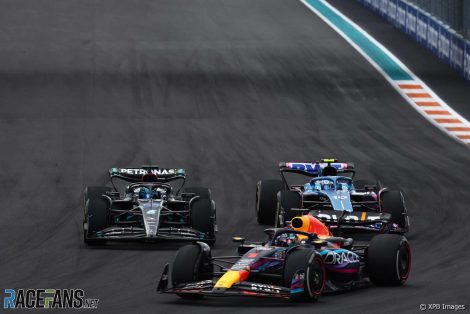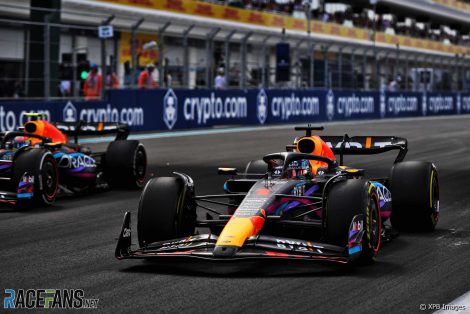Formula 1 drivers warned the slippery track and short DRS zones would make for a processional Miami Grand Prix. So did it produce a race which justified the hype which accompanied it?
The view from the track
There are plenty of reasons to be cynical or negative about the Miami GP that have nothing to do with any of the pomp and pageantry of the pre-race build-up. Or the race itself, separated from all of that.
As a race? It was perfectly and acceptably fine. Hardly the instant classic that last year’s United States Grand Prix at Circuit of the Americas was, but hardly the dull, dragging dreck that was thw previous week’s Azerbaijan Grand Prix in Baku, a circuit which either produces weapons-grade chaos or the F1 equivalent of melatonin.
Would it have been received better if Max Verstappen’s charge from ninth to first didn’t feel so inevitable? That’s subjective to one’s fatigue levels of seeing Red Bull running up front every weekend. The way things are going this year it will take a Turkey 2010 moment to keep them from running the table.
But there were chances to pass and opportunities for drivers like George Russell, Carlos Sainz Jnr, Lewis Hamilton, and Yuki Tsunoda among others to advance their positions throughout the race – even at a circuit where there was not much grip on the racing line, let alone off it, and this was even before monsoon-level rain showers made all the accumulated rubber of the last two days go bye-bye.
It’s fair to expect an event that F1 clearly sees as a crown jewel of its calendar to deliver a quality of race befitting of the spectacle it manufactures around it, for sure. I just thought it was okay. And maybe that’s still good enough to be viewed as one of the better races when 2023 is done.
RJ O’Connell
Advert | Become a RaceFans supporter and
The view from the sofa
The Miami GP theatrics was a reminder to F1 to not over-sell an event which may fail to deliver.

Not only did some of the drivers regard the introduction ceremony a step too far, but the sight of LL Cool J dancing around with female cheerleaders looked like a small step back for women in motorsport and felt far too reminiscent of grid girls. But the pre-race festivities will continue and are expected to be seen at eight races this season, despite the discomfort of some drivers.
What is more concerning, however, is F1 keeps referring to its events as a ‘show’, when it’s not uncommon for a race to be a damp squib. With Red Bull and Verstappen in a league of their own, audiences knew the world champion had a good chance of winning despite starting ninth.
Of course F1 is there for entertainment, and what Liberty and Stefano Domenicali has done is revolutionary – but the race did not deliver, and the jarring activities felt more misplaced as a result.
Entertainment value may be important for F1, but losing sight of why we’re there could be a weakness. If F1 strays too far from its origins it runs the risk of alienating fans by trying to accommodate new ones.
With Imola up next it’s a significant time for F1 to get back to its roots and remind existing fans why they love the sport, especially when the championship doesn’t seem too competitive this season. Miami essentially did not give us what we were promised. Perhaps it’s because the championship feels like it’s already wrapped up just five races in, but something felt off about Miami.
The ‘show’ could overtake the race if things continue this way. But the real selling point of F1 is what happens on-track – everything else is just noise.
Claire Cottingham
Advert | Become a RaceFans supporter and
No change in the script
If Verstappen’s race-winning overtake on team mate Sergio Perez around the outside of turn one would have happened not in F1 but in IndyCar, then the motorsport community would have been raving about it for the rest of this week.

That, admittedly, is a pretty cynical take. But what does it say about F1 and the expectations around the modern on-track product when a grand prix can feature a driver making eight on-track overtakes to win from ninth on the grid using an alternate strategy and sealing success with a daring side-by-side dive for the lead around the outside of their team mate in the closing laps of the race, yet still leave so many fans dissatisfied?
The Miami GP was not one of the best races of the era. It probably won’t be among the most memorable races of the season. But it was a entertaining race. It was an eventful race. It was a race worth watching – not least of which if you were a beauty influencer invited to attend the race in a glitzy hospitality suite as the guest of a popular cosmetics brand.
Miami featured the most on-track of overtakes of any 2023 race so far – almost three times as many as Baku and more than in 2022. And even if most of them felt like they were Verstappen activating warp drive to pass half the field, his double pass on Charles Leclerc and Kevin Magnussen and his race-winning move into the opening corner of the lap were examples of DRS passing at its best.
What Miami showed is that F1 does not have a racing problem – it has a narrative problem. Verstappen’s win was a brilliant achievement rendered pedestrian in how it was a film we’d all seen before. How can there be the same tension, the same awe when we’ve seen him win like that no less than five times in the last 12 months? When Red Bull continue to be as untouchable as they are? Swap the Red Bulls with the Ferraris, Aston Martins or even the McLarens – we would not be having this discussion.
That, ultimately, is why the Miami GP did not satisfy the passionate die-hard fans as much as we all feel it should have. The influencers probably loved it, though.
Will Wood
Advert | Become a RaceFans supporter and
A foreseeable conclusion
I saw Verstappen’s race-deciding pass on Perez entirely differently to Will. For me, there was no tension, no excitement and no drama in that moment because DRS made the move entirely predictable. There is no DRS in IndyCar, so when Romain Grosjean and Scott McLaughlin swapped the lead twice in the final stint at Barber two weeks ago I genuinely couldn’t take my eyes off the screen.

That aside, given the concerns about the quality of racing during the lead-up to the event, and with the title sadly looking like a foregone conclusion already, I thought the weekend as a whole was adequate. Neither a classic nor a stinker – and ordinary races are essential, for without them we’d never appreciate the extraordinary ones.
One week on from a thoroughly underwhelming debut for F1’s latest sprint format, the series should take note that having three practice sessions did not prevent qualifying from producing real excitement and an intriguing grid for the race. It was arguably the highlight of the weekend, and not just because Leclerc’s blunder cost Verstappen dearly. Earlier in the session we had the second-quickest car going out in Q1, Hamilton slipping up in Q2 and six different teams claimed the top six places.
Before the race several drivers warned the FIA’s decision to shorten two of Miami’s DRS zones would make passing too difficult. The race proved those fears were unfounded. Hopefully the FIA paid heed to Carlos Sainz Jnr’s observation that there was a correlation between which drivers complained most about the DRS changes and which of them needed the most help on the straights, and sticks with its policy of shortening the activation zones.
This is essential, because there’s more to what makes a memorable race than the raw total of passes. Battles for position need to be memorable, and that is what DRS all too often prevents.
The celebrities and the ceremonies may have done nothing for me, but is anything really being lost by having them? It’s not essential to watch them. I’ve always found the tedious pre-race anthem rendition a useful opportunity to grab a pre-race cup of tea – if the driver introductions are here to stay I reckon I can squeeze in a round of sandwiches too…
Keith Collantine
Advert | Become a RaceFans supporter and
















